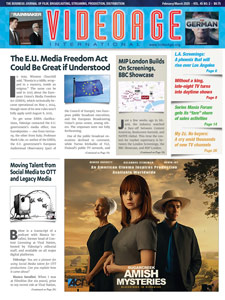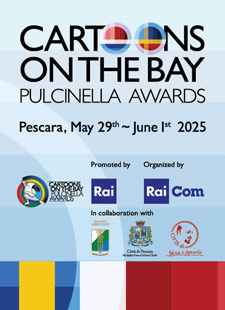By Dom Serafini
Three Emmy organizations are at crossroads: one from Los Angeles, and two from New York City. The one from L.A. is the Academy of Television Arts and Sciences (ATAS, aka the Television Academy). The two from NYC are: the National Academy of Television Arts and Sciences (NATAS) and the International Emmys (IATAS).
They’re part of the same family, share ownership and rights to the Emmy statuette, and produce three distinct awards ceremonies: ATAS primetime, NATAS daytime, and IATAS international. And these days, some observers are asking, in a post-COVID world, in a global era in which programming is produced and aired simultaneously worldwide, and when awards shows suffer from low viewership and the industry’s virtual fatigue, why not combine the three events into one to allow the Emmys to, like a phoenix, rise again? After all, what other awards are divided by regions of the world in this day and age?
This year, a virtual ATAS primetime Emmy Awards show will be broadcast in the U.S. on September 20. It will involve some 140 locations from around the world since the nominated talents will be sending feeds from venues in such places as London, Berlin, Tel Aviv, and various spots in L.A. (The virtual NATAS Daytime Emmy Awards aired on June 26.)
The IATAS Awards, which honor excellence in TV programming produced and initially aired outside the U.S., is expected to take place live on November 23 in NYC. It’s not usually broadcast in the U.S or overseas.
Of the three ceremonies, the weakest is now the International Emmys. It suffers from dwindling membership, high structural costs, decreased revenues, and reduced support from high-level international TV executives. It is also the most expensive of the three for participants, and it asks for expensive annual dues from its members.
In the past, the three organizations adapted to face some turbulent periods, and today they’re faced with a post-pandemic quandary cause by the coronavirus.
ATAS, the oldest of the three, was founded in 1946, and this September will put on its 72nd Emmy Awards ceremony. It first awarded the Emmy in 1949 to honor shows produced in the Los Angeles area before later becoming a national event with the establishment of NATAS in New York City in 1955, which was founded as a sister organization on the East Coast.
Originally, there was only one Emmy event held per year to honor shows nationally broadcast in the U.S., and that ceremony was supervised by NATAS. However, ATAS maintained a separate ceremony to honor shows aired locally in the L.A. area, while NATAS established regional chapters throughout the rest of the U.S., with each one developing their own Emmy ceremony for local programming. In 1974, NATAS also produced the first Daytime Emmy ceremony to honor national daytime programming, while the original show focused on primetime TV programs.
In 1976, when the NYC-based John Cannon (1927-2001) took over as ATAS president (basically ousting Robert Lewine, the sitting L.A.-based president), he pushed ATAS and NATAS to sever ties, but both kept ownership of the Emmy statuette and divided the awards ceremonies: ATAS for primetime and NATAS for daytime programming. NATAS also manages the News and Documentary Emmys and Emmy ceremonies for its 19 local chapters. After Cannon died there were failed attempts to reunite the two groups.
The Emmy is named after a French alteration of the television crew slang term “Immy,” a nickname for the image orthicon, the image captor once used in TV cameras.
IATAS was co-founded by Ralph Baruch (1923-2016, who also founded Viacom) and NBC’s Ted Cott (1917-1973), and originally known as the International Council of NATAS. Later on, the Council added Renato M. Pachetti (1925-2003) of Italy’s RAI as its third operative. But there are a few discrepancies about IATAS’ origins.
In his autobiographical book Television Tightrope: How I Escaped Hitler, Survived CBS and Fathered Viacom (which was reviewed in the June 2007 Issue of VideoAge), Baruch wrote that the first International Academy Emmy Awards gala ceremony was held in 1963, but in1985, in VideoAge‘s International Council Membership Directory, contributing editor Ken Carlton wrote that NATAS chartered the Council in 1968. Carlton is the son of the Council’s first executive director, Richard Carlton, who was hired by Baruch and Pachetti in 1983 (before that, it functioned as a voluntary organization). Then, in VideoAge’s 1991 Salute to Pachetti, he told the reporter that the organization was started in 1967. In 1975, Pachetti was nominated as chairman.
According to Wikipedia, IATAS was founded in 1969, and although it is part of NATAS, it operates under its own board of directors. It also added that the “first International Emmy Awards were carried out in 1973, and was organized by Ralph Baruch in a ceremony held at the Plaza Hotel in New York City. About 200 guests attended the event.”
Baruch made it clear in his book that he was worried about what might happen to the Emmys in the future. “Concerned about possible proliferation of Emmys, we restricted the awards to two categories: Fiction and Non-Fiction.”
On a personal note, in the late ’80s, Pachetti and Baruch arranged to change the Academy’s by-laws so that the organization would accept this journalist as a member (before that journalists were not allowed as members), and, in 1990, Gillian Rose left as VideoAge’s editorial director in London to join the Academy as Program Manager.
Finally, VideoAge‘s 2007 review of Baruch’s book noted that “many of the people who resigned from the International Academy hope [that Baruch] will bring the organization back to past glories.” Today, the phoenix will.












Leave A Comment